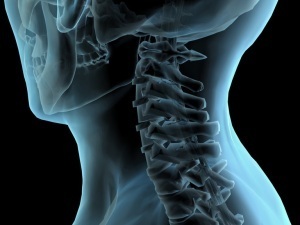Signs of a strong manifestation of cervical osteochondrosis usually surprise the patient, although the preconditions for the disease can be observed long before the onset of the main symptoms and the consequences of degenerative changes in the structure of the vertebrae. The nerve roots (cervical spine) of C5, C6, C7 levels are most often affected.
Clinical manifestations
Symptoms of cervical osteochondrosis are divided into radical and reflex.
Reflex syndrome

Lumbago is characterized by reflex symptoms. Their main feature is a sudden appearance with an awkward motion, jerking or holding the head in a long position in one position. The lumbago of the cervical spine literally knocks the person out of the rut, the movements become restricted, the patient is forced into pain due to severe pain.
Common patient complaints:
- contractile headache radiating to the temple or eyeball;
- decreased visual acuity in the eye as if "everything was floating";
- possible pressure rise.
Vertebral artery syndrome occurs when the nerve plexus is irritated and is often misdiagnosed as a cerebrovascular accident. Manifestations of cervical osteochondrosis with a similar syndrome are frequent dizziness, which occurs with a sharp turn of the head, almost always accompanied by unpleasant nausea and even vomiting.
It is important to rule out cerebrovascular accidents when making a diagnosis, as the treatment of osteochondrosis is fundamentally different from the treatment of vascular diseases.
With cardiac symptom in the clinic of reflex syndromes of cervical osteochondrosis, the patient is characterized by sensations similar to an attack of angina pectoris, but difficulties in accurately diagnosing the disease are generally not observed because cardiac symptoms are characterized by a number of osteochondrosis.
Radicular syndrome
Signs of cervical osteochondrosis occur in radical syndrome in direct proportion to the "number" of the compressed nerve.
Symptoms, sensory and motor changes depend on which nerve root is involved:
- C1- sensitivity is impaired in the occipital region;
- C2- the patient feels pain in the parietal and occipital region;
- C3- the pain appears in the half of the neck where the violation occurred. Symptoms: decreased sensitivity, disturbance of work and touch of the tongue, speech problems;
- C4- there is pain in the shoulder-shoulder region, sensitivity is impaired, it can hurt the heart and liver;
- C5- the patient does not feel well on the outer surface of the shoulder, worried about pain in this area;
- C6- pain in osteochondrosis at the level of the 6th vertebra extends to the forearm, shoulder blade, radial surface and “descends” to the thumb of the hand;
- C7- pain "spreads" from the neck to the shoulder blade, passes through the back of the shoulder and forearm, goes to 2-4 fingers of the hand, sensitivity in this area deteriorates;
- C8- the pain is localized from the neck to the shoulder and then to the little finger.
inseparable pathological connection

VSD and cervical osteochondrosis are closely related, and vegetative-vascular dystonia can manifest as a consequence of damage to the cartilage of the cervical joint, which relaxes the human nervous system. Concomitant dystonia and osteochondrosis may be a common disease or VSD may occur for common reasons.
Osteochondrosis is one of the factors that provokes VSD, but it is not necessary for the second to follow from the first.
Vegeto-vascular dystonia often manifests itself in different types of osteochondrosis, especially cervical spinal disorders. But it can also manifest itself as a result of injury, the nerves in the cervical spine being compressed, blood flow deteriorating and pressure inside the skull rising.
Diagnostic Errors
VSD, osteochondrosis, and chest pain are treated fundamentally differently. Expensive (and often unnecessary) examinations show nothing but problems in the cervicothoracic region and disturbances in the work of blood vessels. In this case, the treatment often remains the same - cardiac complexes, vitamins, antidepressants. Chiropractors eliminate pain, put the patient in an optimistic mood, but panic attacks, stress, and fatigue lead nowhere.
More and more people are falling victim to improper therapy, panic attacks (or attacks of VSD) are becoming almost common to them, but many patients prefer self-medication or visiting “doctors” whose activity is not just getting rid of the disease. for self-enrichment.
Typical groups of manifestations
The main clinical signs of osteochondrosis of the neck can be divided into several groups:

- first
- .Neurological symptoms occur as a consequence of complications of cervical osteochondrosis, as a result of direct pressure on the nerve roots, nerve braids;
- seconds.Symptoms occur when they directly affect the spinal cord;
- third.Symptoms occur in the brain, affecting blood vessels, structures, membranes, and the trunk.
Each of the groups listed has its own clinical signs and manifestations, but the symptoms are common, making it possible to make a correct diagnosis.
Symptoms of cervical vertebral osteochondrosis often present as a neurological complication characterized by shoulder joint pain. This pathology is called "shoulder scapular periarthritis. "
The distinguishing features of spinal cord compression in the cervical region are volumetric tissue changes and a strong decrease in important functions. Skin and muscle sensitivity deteriorates, paresis develops, and in complex pathological cases, paralysis.
That is why, even if you have the first suspicion of cervical osteochondrosis, it is important to see a specialist, take the necessary diagnostic measures and carry out a course of treatment. Keep in mind that pathology detected in time will disappear quickly and without consequences.



































